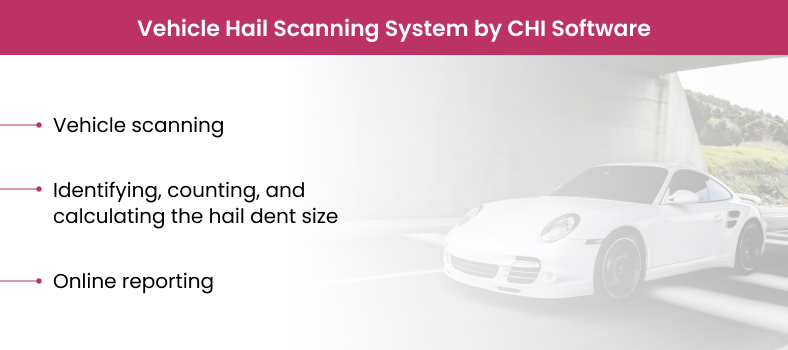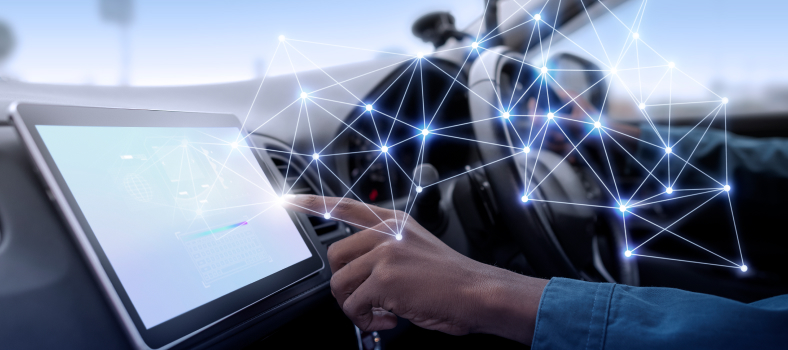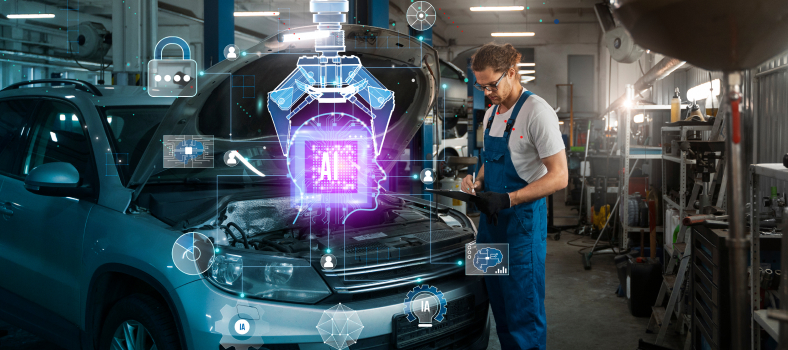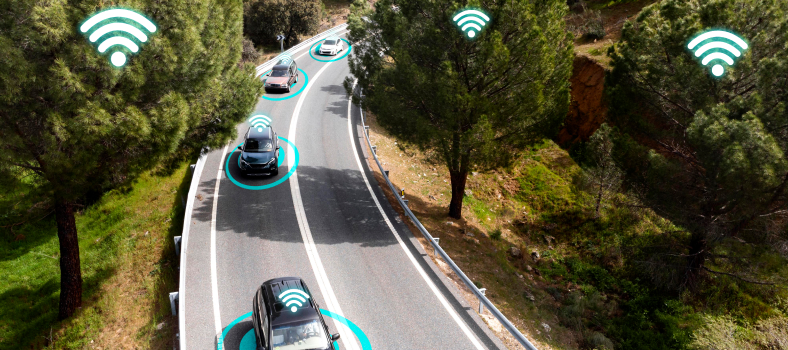Ever scratched your car in a tight parking lot and cringed at the thought of the repair bill? So many of us have been there. But what if technology could detect that damage instantly and provide an estimate to fix it? The future is here, and AI is transforming vehicle damage detection in ways that will save the driver’s time, money, and a whole lot of stress.
Advances in computer vision, machine learning, and image processing have enabled AI systems to identify dents, scratches, and other imperfections on a car with high accuracy. AI-powered vehicle damage detection uses cameras to scan an entire car and provide detailed reports on any damage within minutes. How exciting is that?
We welcome you on a journey exploring the universe of innovative features for effective automotive repair. AI algorithms for accident analysis can surprise you in a big way, and we will prove that to you with our real-life case study.
AI in Automotive Repair: Vehicle Hail Scanning System by CHI Software
Our story begins with a particular car damaging issue – hail. You would probably agree that it is a challenging weather phenomenon, particularly for car owners. One can vividly imagine those big and small dents that hail often leaves on vehicles. But it is not the only problem here.
Currently, reporting these dents relies heavily on drivers themselves, which often introduces a degree of human error. Moreover, manually inspecting and verifying these reports is a time-intensive task. As a result, the precise cost and time for repairs remain uncertain at the initial reporting stage. Luckily, automated vehicle inspection with AI is a powerful solution for all the issues mentioned.
Intro to Our Project
Our client’s company is located in the Netherlands, which is famous for having around 130 days of rain (and other precipitation) per year. So, not surprisingly, there was an urgent need for a software solution streamlining hail damage assessment on vehicles.
The project aimed to eliminate slow and error-prone manual review by introducing car damage detection technology that accurately identifies hail dents, with a desired accuracy rate of at least 80%. This system would not only identify the damage’s extent but also do it much faster than current methods.
Fascinated about AI trends? We've prepared a guide on image recognition innovations in 2024
Read more
The challenge here was the uncertainty in estimating repair costs and time immediately after an incident due to the manual nature of damage evaluation.
Central to this initiative was an advanced vehicle hail scanning system designed to automate damage detection by capturing real-time images and accurately assessing the severity of the damage.
The client was looking for a solution to be developed and implemented within a very tight timeframe, emphasizing the need for efficiency and prompt delivery.
Real-Time Vehicle Damage Recognition Made Easy by CHI Engineers
So, can an insurance app detect accident damage to the vehicle? Our engineers give it a definite yes! The system delivered by the CHI Software team provides smart vehicle damage analysis, efficiently detecting all forms of hail damage on vehicles, including minor scratches. And all that is done in just around one minute! Has it ever been easier than with this solution?
Are you fascinated about AI implementation for various business purposes? We have exciting reading for you!
Check out our case studies
Here’s a closer look at how this AI-enabled auto repair estimation works:
- Vehicles pass through a specially designed light tunnel that houses advanced optical cameras;
- High-resolution cameras, in conjunction with sophisticated software, systematically identify every dent on the vehicle. This process results in a detailed report categorizing the damage’s extent;
- The data about the vehicle’s condition is then compressed and securely stored in cloud storage, ensuring both data integrity and easy access.
How Innovations in Vehicle Damage Assessment Help Our Client

How damage detection can work with computer vision capabilities
The best AI tools for damage detection can improve traditional business operations in many ways. But some benefits stand out the most. Here they are:
- Our client has taken their services to the next level at their stations. Now, they can precisely gauge the damage and meticulously inspect the vehicle’s surface. This addition not only enhances their service portfolio but also offers customers a detailed understanding of their vehicle’s condition;
- The versatility of the data gathered by this system extends far beyond damage assessment. It is also an invaluable tool in insurance scenarios, swiftly determining the impact of hailstorms and offering clarity and speed in situations that demand prompt action;
- With cloud services, the transfer of detailed damage reports is just a few clicks away, streamlining the communication between vehicle owners and insurers and enabling fast and smooth AI-based insurance claim processing.
Eager to learn more? Follow this link to learn exciting details about the project and its tech stack. If you want to talk to our experts directly and discuss your idea in detail, then book your call now.
Advanced Vehicle Diagnostics with AI: Top 7 Technologies That Change the Game
Our practical example has hinted at some great AI advancements used to build one-of-a-kind solutions for car damage analysis. What are they? The following technologies will give you a better understanding.
Machine Learning (ML)

When we talk about machine learning in automotive damage detection, we look at a scenario where computers are taught to identify and assess vehicle damage, like training a super-smart assistant. This involves feeding machine learning algorithms lots of data (images of cars in various damage states). Over time, these algorithms learn to recognize patterns and differences between a damaged and a non-damaged vehicle.
Precision or Tradition? Comparing AI and Manual Hail Inspection Techniques
Read more
Deep Learning
Now, moving on to car damage detection using deep learning. Deep learning is an ML subset with more advanced capabilities. It uses something called neural networks designed to mimic human brain functioning. In the context of artificial intelligence for car damage assessment, deep learning models are trained with vast amounts of image data. These models can detect not just obvious damages like big dents, but also subtle ones like small scratches or paint chips. They can even determine the severity of the damage.
Computer Vision (CV)

It is hard (if not impossible) to imagine smart vehicle damage analysis without computer vision. It is like giving a computer the ability to see and interpret the world, much like human eyes and brains do.
Deep learning and computer vision algorithms work together to detect minor dents or slight discrepancies in a paint color that might suggest a repair job. Such an AI tool for accident car workshop is essential when assessing the condition of a used car or processing an insurance claim after an accident or a hailstorm.
Basically, computer vision in car damage recognition is a fundamental technology that made our project successful. Remember that finding a professional CV team is your number-one task when building reliable damage detection software.
Artificial Intelligence (AI) and the Evolution of Car Inspections
Read more
Predictive Analytics
Using AI-driven predictive maintenance for vehicles is like having a crystal ball but for cars. AI systems constantly monitor the vehicle’s condition using various sensors and data inputs. These could be anything from engine temperature, vibration data, and oil conditions to even driving patterns.
The system then crunches all this data to predict when a part might fail or if the vehicle is heading toward a potential problem. It is like a smart mechanic inside a car who is always on the lookout, warning you before something goes wrong. This proactive approach is a huge leap from the traditional ‘wait till it breaks’ method. Predictive analytics in vehicle maintenance prevents damage before it occurs, saving time, money, and a lot of headaches.
Natural Language Processing (NLP)
Imagine a scenario where a driver needs to report damage to their car. Traditionally, they might fill out a form or describe the damage via phone or email. This is where NLP comes in. It can analyze the driver’s description, whether spoken into a voice recognition system or typed into a text field, and understand the specifics of the damage. It could be anything from “a large dent on the driver’s side door” to “scratches near the rear bumper.”
NLP systems are trained to pick up on these descriptive keywords and phrases. They can then categorize the damage’s type and location, as well as suggest the severity level. This information can be incredibly valuable for insurance companies or repair shops, helping them prepare in advance for the repair work needed.
The two following innovations, edge computing and sensor fusion, power up the AI capabilities we already described. Mixed together, they provide the best possible quality of damage detection.
Edge Computing

Edge computing is another option to fuel automated anomaly detection in vehicle inspections. Let us say vehicle damage detection sensors are installed on a vehicle or at an inspection station to capture images or videos of the vehicle’s exterior.
In a traditional setup, these images would be sent over the internet to a central server where AI lives to analyze them. But with edge computing, an AI tool is right there with the cameras and sensors and can start working on the data as soon as it is captured. For a driver or vehicle fleet manager, this means getting immediate notifications if there is any damage.
Not sure what AI tech to use for your project? We're here to give you a clear vision
Let's talk!
Sensor Fusion
Sensor fusion basically combines data from different sensors to comprehensively understand a situation. In cars, these sensors can be anything from cameras and radar to ultrasonic and lidar sensors.
When we add AI into this mix, things get really interesting. AI acts like the brain that takes in all this diverse sensor data and makes sense of it.
What is really neat is that this AI-powered analysis can happen in real time. So, if a car gets hit by a hailstorm or is involved in a minor bump, the system can immediately detect and assess the damage. This information can be crucial for drivers for immediate repairs or insurance claims.
Conclusion
So, that is how you can enhance vehicle safety with AI car damage detection. Pretty soon, the days of manually inspecting vehicles and relying on human judgment alone will be a thing of the past. Instead, AI algorithms for damage analysis in vehicles will do the heavy lifting by spotting dents, dings, and scratches that the human eye could easily miss.
The future is coming; is your business ready for vehicle damage detection using AI? To find out how AI can benefit your company, start with a proof of concept. You will be able to see the first results within a month and decide whether AI is your thing in terms of damage detection.
To simplify it for you, as a computer vision development company, we already gathered a great team of computer vision, machine learning and image recognition solution engineers under one roof. They are all you need to start small and achieve great results shortly. How about having a quick chat? Just leave your message here to make your first step toward the future.
FAQs
-
What is AI-based vehicle damage detection?

AI vehicle damage detection is a tech ability to quickly spot dings, dents, and scratches on cars. It uses machine learning, computer vision, natural language processing, and other AI innovations to scan and analyze a vehicle's exterior, doing it faster and more accurately than human eyes.
-
What types of damage can AI detect on vehicles?

AI can spot a range of issues like dents, scratches, and even chipped paint on cars. Think of it as a high-tech detective that doesn't miss a thing, from small blemishes to more obvious damage.
-
How much does it cost to integrate AI for vehicle damage detection?

No company can name you exact sum right from the start. But you should know that most of AI projects start with a proof of concept to test the idea. The cost for this type of work usually starts from 10,000 USD and depends on your requirements, risks, and data at hand.
-
How does AI vehicle damage detection integrate with insurance processes?

When AI tools spot damage, they can quickly tell your insurer what's up and make the whole claim process smoother and faster. Drivers don't even have to bother tapping any buttons – it can be a fully automative operation.
-
How do AI damage detection systems handle data privacy?

Just like how we keep our personal information safe, AI systems protect your car's data using strong encryption and privacy policies. They make sure only the right eyes see your vehicle's information, keeping it away from prying eyes. So, while the AI is busy figuring out the nicks and dents on your car, it also makes sure that your car's details stay your business and nobody else's.
About the author
Alex is a Data Scientist & ML Engineer with an NLP specialization. He is passionate about AI-related technologies, fond of science, and participated in many international scientific conferences.
Rate this article
24 ratings, average: 4.5 out of 5







